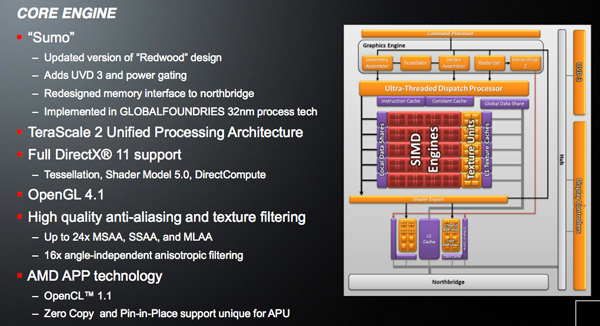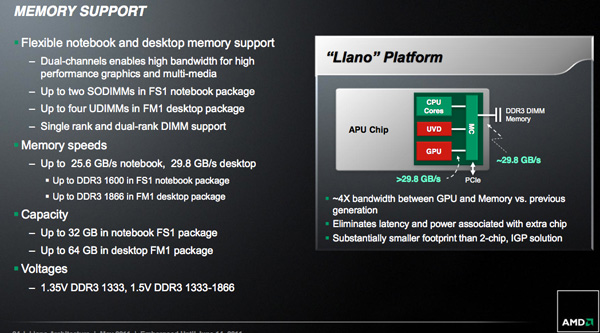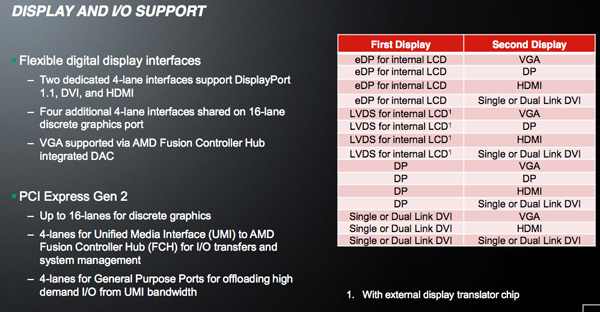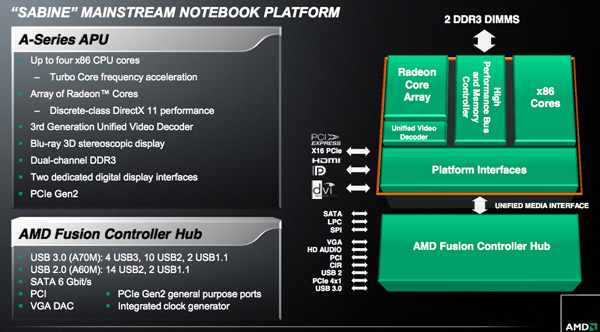The AMD Llano Notebook Review: Competing in the Mobile Market
by Jarred Walton & Anand Lal Shimpi on June 14, 2011 12:01 AM ESTThe GPU
While the Llano CPU cores may be in need of a major overhaul, Llano's GPU is as new as it gets. Technically based off of AMD's Redwood core (Radeon HD 5570) with some enhancements, Llano's GPU is codenamed Sumo.
The DX11 GPU features five SIMD arrays, each with 80 cores for a total of 400 shader processors. Similar to the updates we saw with this year's Northern Islands GPUs, Sumo does add UVD3 support to the Redwood architecture. Of course since Sumo shares the same die as the Llano CPU cores it is built on GlobalFoundries' 32nm process, making this the first AMD GPU fabbed at GlobalFoundries and not TSMC.
For everything behind the memory controller Sumo is virtually identical to Redwood. Where Sumo differs is in its memory interface. Although Llano is AMD's first performance oriented APU, it's still constrained by a 128-bit wide DDR3 memory interface. That dual-channel memory interface has to be shared by all four Llano cores as well as the Sumo GPU and as a result, arbitration is very important.
AMD shared a few choice details about the Llano memory controller architecture. To begin, AMD guarantees more than 30GB/s of bandwidth is available between the GPU and the memory controller—in other words, the path from GPU to the memory controller won't become a bottleneck. The GPU/memory controller link (i.e. within the APU die) can apparently scale up to as much as 50GB/s to support future APUs with even faster memory interfaces. Note that unlike previous integrated graphics solutions, there is no support for dedicated external memory—this is a pure shared memory architecture.
Second, and most importantly, AMD can dynamically prioritize memory bandwidth between the CPU and GPU. In most cases, when both processors are heavily consuming data, the GPU is given priority over the CPU. Given today's workloads, prioritizing the GPU for memory accesses makes sense when it's running full tilt. The chances of you stressing all four CPU cores and running at full GPU memory bandwidth requirements are pretty slim today.
With 400 shader processors behind a shared 128-bit DDR3 memory interface, the upper bound for Sumo performance is the Radeon HD 5570. In practice, you should expect performance to be noticeably lower since the GPU does have to share its precious memory bandwidth with up to four x86 CPU cores.
The mobile version of Llano supports up to DDR3-1600 while the desktop parts can run at up to DDR3-1866. Maximum memory capacities are 32GB and 64GB for notebooks and desktops, respectively.
Llano has a total of 24 PCIe Gen 2 lanes at its disposal. Sixteen of those lanes can be used for external graphics. Four of the lanes can be used for devices that need low latency/high bandwidth access to the APU itself (e.g. Gigabit ethernet). The remaining four lanes are used to connect the APU to its sole partner in crime: the Fusion Controller Hub.
AMD is particularly proud of the display output configurations supported by Llano. The possible combinations are listed below:
Chipsets
AMD will offer two Fusion Controller Hubs (FCHs) as options for Llano: A70M and A60M. The only difference between the two is in their support for USB 3.0; the A70M has four USB 3.0 ports while the A60M has none.
Both FCHs support 6Gbps SATA and perform just as well as AMD's 8-series chipset (or Intel's Z68) with a high performance SSD. USB 3.0 performance is also comparable to 3rd party solutions we've seen deployed on motherboards already.















177 Comments
View All Comments
JarredWalton - Tuesday, June 14, 2011 - link
Civ5 and TWS2 are both tested with the latest drivers. The K53E was also tested with drivers that are at most a couple months old. Intel current lists the latest laptop drivers as 15.22.1.64.2361 from 4/13/2011, which is what I'm running on the Intel units right now. If there are some newer drivers that I'm missing out on, let me know and I'll go try them.duploxxx - Tuesday, June 14, 2011 - link
Nice review, it seems like there is a lot of work on CF.Actually I reviewed the Liano already months ago, I mentioned in the last mobile reviews that it will be better performing then the Toshiba with the P920 with really good battery performance. So it is a win -win for the budget line anyhow. Top line remains intel for the CPU power.
Regarding the quote:
Now if you want to have your cake and eat it too, the APU to wait for would be Trinity. Due out somewhere in the 2012 - 2013 timeframe, combine a Bulldozer derived architecture with AMD's next-generation GPU architecture and you've got Trinity.
Trinity will not only be an improved GPU it also has the BD core inthere which will offer much more punch. THe reason LIano is late is because of the 32NM process. It could have been released much sooner. Sure they took an outdated K10 and that is the main issue together with the not enough aggressive Turbo for single thread, they should have adapted this more aka BD.
But assumin Trinity is a rather late 2012 project (by stating 2012-2013) you are way way off...
ET - Tuesday, June 14, 2011 - link
Quote probably reflects an increase in pessimism due to recent events. Bulldozer is still not out, and AMD is said to have had a hard time getting clocks up. So sure, we're all hoping to see Trinity early in 2012, but anyone setting their expectations a little farther are less likely to be disappointed.duploxxx - Wednesday, June 15, 2011 - link
didn't i mentioned it would be launch faster then expected?http://www.cpuforever.com/showthread.php?tid=1574&...
the delay of Zambezi BD has nothing to do with real architecture issues.....
ET - Wednesday, June 15, 2011 - link
That's not the sites which posted on it, including Anandtech, said based on what AMD said (that is, that Bulldozer was not up to speed).Jamahl - Tuesday, June 14, 2011 - link
Was that really needed? I mean...really? Who the hell would do that and for what reason?ET - Tuesday, June 14, 2011 - link
I already got my E-350 laptop, but as Jarred says, Brazos just became less interesting. I'll be waiting to see what price point and performance the dual core Llano will have. What impressed me most was battery life, which is competitive with the E-350 laptop, and it'd be interesting to see how small and light Llano laptops will get.The other takeaway I have from this is that as usual I'm impressed at how far Intel has gone with its integrated graphics. Sure Llano gives it a good beating, but that's at the expense of a lot more die space. I imagine that Intel will continue to tweak its 3D cores and I can't wait to see how this race will develop.
Anosh - Tuesday, June 14, 2011 - link
What happened to power consumption?!Some of us get laptops due to the optimization in the power department over similar desktop parts!
JarredWalton - Tuesday, June 14, 2011 - link
Power = [Battery Capacity] / .98 [efficiency] / ([Battery life in minutes] / 60)So if you take the battery life charts, you can determine roughly what the total system power draw is using the above. Or you can look at the "Relative Battery Life" charts and get the same information as Minutes/Wh instead of converting into Watts.
jabber - Tuesday, June 14, 2011 - link
In my work I get a lot of laptops to fix. If there is one game or genre that appears on 80% or more of them its......The Sims.
I also get asked a lot "if I buy this laptop will it play The Sims?"
Never ever been asked if a laptop will play Crysis or any of the games you use.
Just saying.